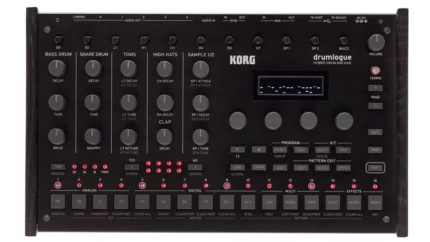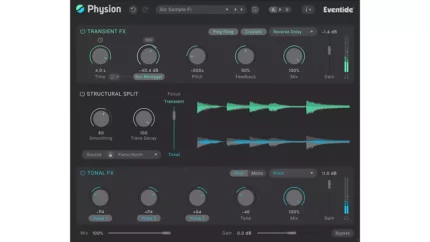Korg drumlogue Drum Machine Available Now to Pre-Order
Korg finally unveils Drumlogue, a hybrid drum machine that can also be used as a fully-fledged synth – is now available to pre-order.
It’s been more than 18 months, – but Korg has finally launched Drumlogue, which it’s called its “first hybrid drum machine”.
Offering both analogue and digital sounds, this also includes an expanded version of the Multi-Engine found in other ‘logue products, which enables you to customise your Drumlogue with new synth sounds.
drumlogue features new analogue circuitry from Korg engineer Junichi Ikeuchi, who’s previous projects include the ARP 2600 M, MS-20 Mini and ARP Odyssey . This is used to generate kick, snare and low/high tom sounds, which promise to give your tracks “harmonic richness and a thick low end” The most important controls for each of these parts have dedicated knobs on the front panel that can be tweaked at any time, without any menu diving necessary, so you can quickly and intuitively fine tune your sound.
You can augment these analogue sounds with seven digital parts, six of which are sample-based and one of which uses the aforementioned Multi-Engine. The sample-based parts can play both the built-in PCM tones and your own samples, which can simply be dragged and dropped from a computer over USB.
Multi-Engine and logue SDK
The expanded Multi-Engine now features Variable Phase Modulation (VPM) and noise generator engines, plus a new user custom slot that can host fully-fledged synth voices, complete with filters, LFOs, MIDI-controlled polyphony and other parameters.
To give you a taste of what this technology is capable of, Korg has collaborated with popular logueSDK plugin developer Sinevibes. Korg is including Nano, a new Drumlogue plugin from Sinevibes, which has previously developed a number of highly-regarded plugins for other ‘logue instruments. This is described as a fully-fledged synth with dual oscillators, optional ring modulation, a 4-pole state-variable filter with soft clipping distortion, built-in EG and built-in multi-waveform LFO.
A Sequencing Powerhouse
What’s more, drumlogue boasts a sequencer – a 64-step powerhouse that enables you to generate complex patterns and polyrhythms. Features include per-step probability, per-step alternate trigger patterns, per-step micro offsets, per-track groove patterns and more. You can navigate and edit sequences on the OLED display.
And Chain mode, which enables you to create longer, more interesting patterns. Additionally, you can use Loop mode to switch between variations, and it’s said to be easy to record motion and accents. A randomisation feature is on hand for instant experimentation.
Effects and Customization
drumlogue includes several high-quality effects. Effects are split into three categories – delay, reverb and master – that can be used simultaneously. The send amounts for the delay and reverb effects are set independently, with multiple return points also available.
Although the master effects apply to your whole groove, they can be bypassed on a per-part basis, so they’re only processing the parts of your choice. The master effects section has a sidechain, bus, as well. There’s also an audio input, meaning that other instruments can be processed through Drumlogue’s effects. Each effect can implement up to 24 parameters.
Connectivity
Speaking of I/O, Drumlogue has plenty of it, including a USB-A port for connection to class-compliant MIDI devices, standard MIDI I/O, sync I/O and USB MIDI. For example, control each part’s volume with the nanoKONTROL2 faders, or trigger sounds using the velocity sensitive pads on the nanoPAD2, adding extra levels of expression and integration. On the audio front, there are four individual outs, and headphone and main L/R outputs. Any part can be assigned to any output, so you’ve got plenty of routing flexibility.
Last but not least, Drumlogue’s design promises to make it accessible and easy to use. The key parameters for the main drum parts have dedicated front-panel knobs for realtime adjustment, while dedicated volume pots for each part are designed to speed up the mixing process. The OLED screen, meanwhile, is said to have a simple UI that can be navigated using four dedicated encoder knobs.
You’ll also note the angle of Drumlogue’s main panel – it’s slanted towards the user for better ergonomics and visibility. The body of the machine is aluminium, and there are wooden side panels.
What they say about it:
“drumlogue marks a paradigm shift in drum machines. It offers the raw power and rich sounds of Analog, the flexibility of Digital voices, and drumlogue’s SDK for fully customizable User Custom Synthesizers.
On top of that, its heavy-duty, dynamic sequencer, customizable effects, and intuitive controls will make drumlogue a must-have in your studio to create music for any genre or style.
It’s time to take your beats and entire musical process to a whole new creative level with incredible sounds, effects, customization, and sequencing. Let drumlogue support your craft on your musical journey!”
Features:
- Threefold Hybrid: Analog x Digital x SDK multi engine
- Front Panel Knobs: Kit Control x Mixer
- Powerful Sequencer: 11 parts, 64 step sequencer, Chain Mode (Combine Programs for song mode), Loop, Expand, Groove, Randomize (Pattern or Part)
- Customizable Effects: Delay, Reverb, Master; Per Part or Entire Program
- Connectivity: 6 Audio Outputs, Audio SYNC IN/OUT, AUDIO IN, MIDI I/O (5 pin), USB A (TO DEVICE), USB B (TO HOST)
The Korg drumlogue is available now to pre-order for about $600/£529. We’re expecting Drumlogue to be available towards the end of 2022. Find out more on the Korg website.







